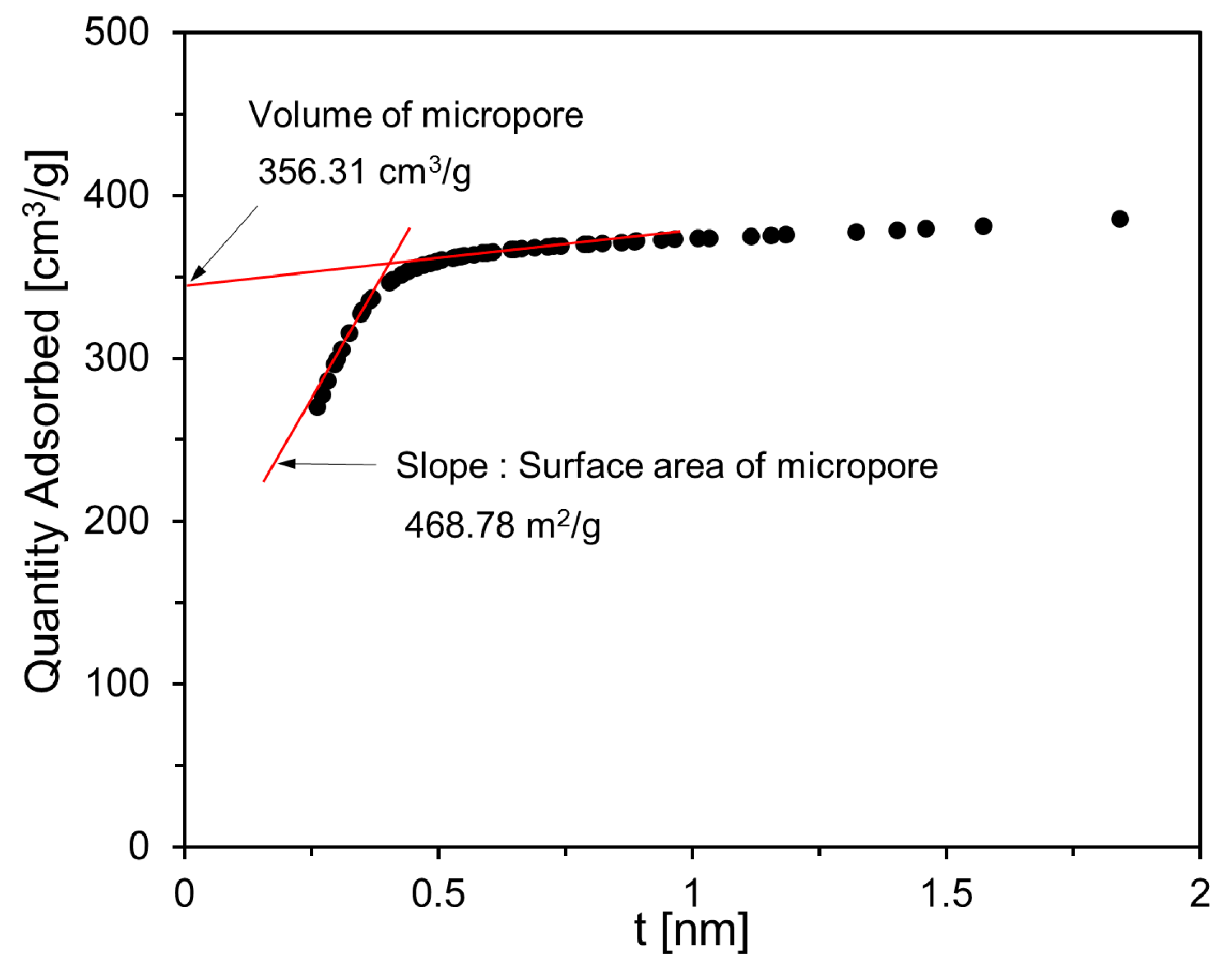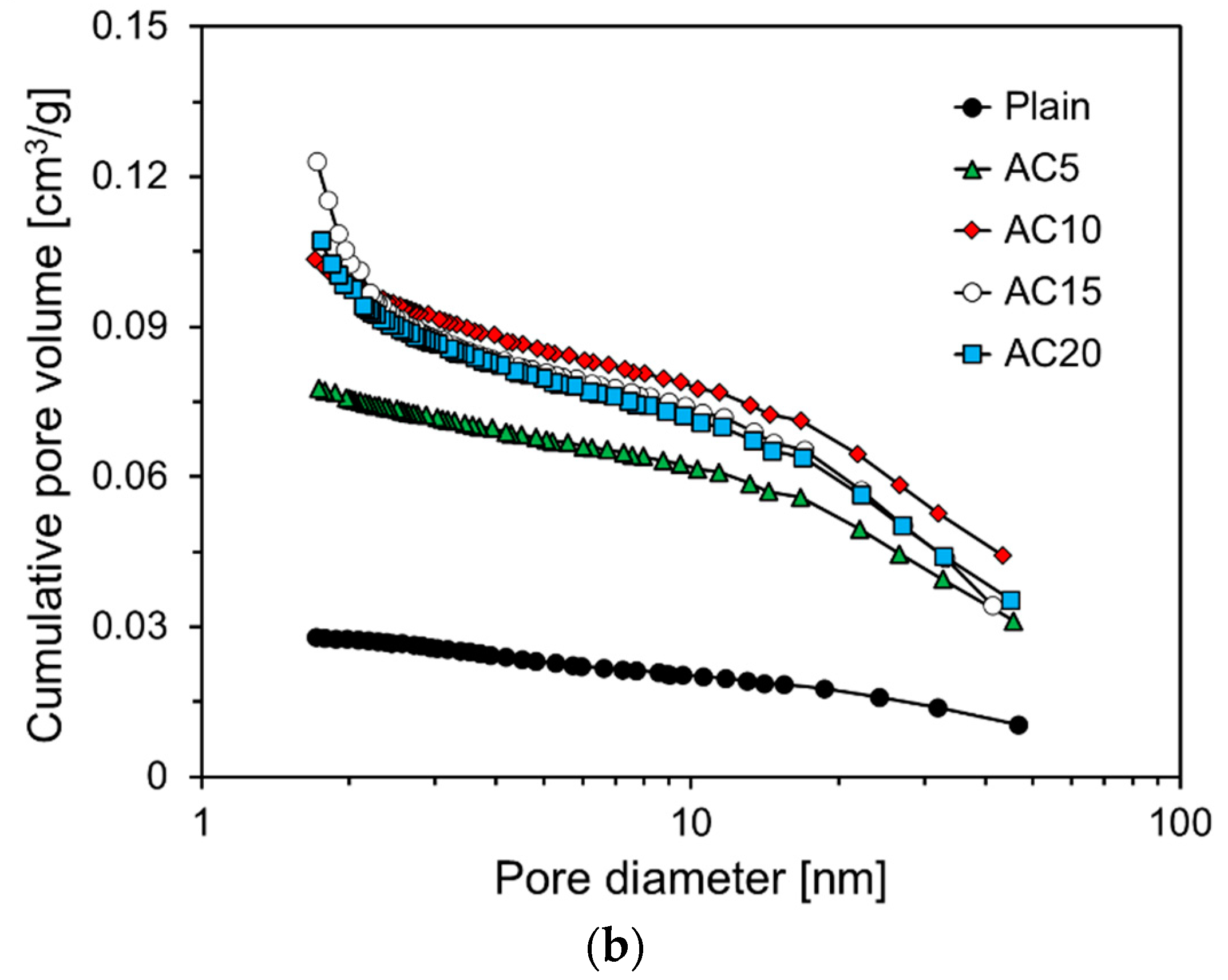Pore Structure Characteristics of Foam Composite with Active Carbon
Abstract
:1. Introduction
2. Experimental Program
2.1. Materials
2.2. Mix Proportions
2.3. Test Methods
3. Results and Discussion
3.1. Pore Structures of Foam Composite
3.2. Specific Surface Area of Foam Composite
3.3. Micropores of Foam Composite
3.4. Pore Size Distribution of Foam Composite
4. Conclusions
Author Contributions
Funding
Conflicts of Interest
References
- National Air Pollutants Emission Service, Emissions of Pollutants in 2016. Available online: https://airemiss.nier.go.kr/ (accessed on 6 May 2020).
- Moon, D.C.; Kim, C.S.; Park, I.Y.; Kim, M.R.; H, S.S.; Lee, K.H.; Lee, C.G. Liquid Phase Adsorption of Activated Carbon Fibers. J. Anal. Sci. Technol. 2000, 13, 573–583. [Google Scholar]
- Pak, S.H.; Jeon, M.J.; Jeon, Y.W. Study of sulfuric acid treatment of activated carbon used to enhance mixed VOC removal. Int. Biodeterior. Biodegrad. 2016, 113, 195–200. [Google Scholar] [CrossRef]
- Kang, K.H.; Kam, S.K.; Lee, S.W.; Lee, M.G. Adsorption Characteristics of Activated Carbon Prepared From Waste Citrus Peels by NaOH Activation. J. Environ. Sci. 2007, 16, 1279–1285. [Google Scholar] [CrossRef] [Green Version]
- Pap, S.; Radonic, J.; Trifunovic, S.; Adamovic, D.; Mihajlovic, I.; Miloradov, M.V.; Sekulic, M.T. Evaluation of the adsorption potential of eco-friendly activated carbon prepared from cherry kernels for the removal of Pb2+, Cd2+ and Ni2+ from aqueous wastes. J. Environ. Manag. 2016, 184, 297–306. [Google Scholar] [CrossRef] [PubMed]
- Son, H.K.; Sivakumar, S.; Rood, M.J.; Kim, B.J. Electrothermal adsorption and desorption of volatile organic compounds on activated carbon fiber cloth. J. Hazard. Mater. 2016, 301, 27–34. [Google Scholar] [CrossRef]
- Yavuz, R.; Akyildiz, H.; Karatepe, N.; Çetinkaya, E. Influence of preparation conditions on porous structures of olive stone activated by H3PO4. Fuel Process. Technol. 2010, 91, 80–87. [Google Scholar] [CrossRef]
- Hagemann, N.; Spokas, K.; Schmidt, H.P.; Kägi, R.; Böhler, M.; Bucheli, T. Activated carbon, biochar and charcoal: Linkages and synergies across pyrogenic carbon’s ABCs Water. J. Water. 2018, 10, 1–19. [Google Scholar] [CrossRef] [Green Version]
- Diamond, S. Mercury porosimetry: An inappropriate method for the measurement of pore size distributions in cement-based materials. Cem. Concr. Res. 2000, 30, 1517–1525. [Google Scholar] [CrossRef]
- Léon, C.A.L. New perspectives in mercury porosimetry. Adv. Colloid Interface Sci. 1998, 76, 341–372. [Google Scholar] [CrossRef]
- Barrett, E.P.; Joyner, L.G.; Halenda, P.P. The determination of pore volume and area distributions in porous substances. I. Computations from nitrogen isotherms. J. Am. Chem. Soc. 1951, 73, 373–380. [Google Scholar] [CrossRef]
- Powers, T.C.; Brownyard, T.L. Studies of the physical properties of hardened Portland cement paste. ACI J. Proc. 1947, 43, 845–880. [Google Scholar] [CrossRef]
- Choi, Y.J.; Lee, Y.S.; Im, J.S. Effect of pore structure of Activated Carbon Fiber on Mechanical Properties. Appl. Chem. Eng. 2018, 29, 318–324. [Google Scholar] [CrossRef]
- Snoeyink, V.L. Adsorption of organic compounds. In Water Quality and Treatment; Pontius, F.W., Ed.; McGraw-Hill: New York, NY, USA, 1990; pp. 781–875. [Google Scholar]
- Corcho-Corral, B.; Olivares-Marin, M.; Fernandez-Gonzalez, C.; Gomez-Serrano, V.; Marcias-Garcia, A. Preparation and textural characterization of activated carbon from vine shoots (Vitis vinifera) by H3PO4-chemical activation. Appl. Surf. Sci. 2006, 252, 5961–5966. [Google Scholar] [CrossRef]
- Wu, F.C.; Tseng, R.L.; Juang, R.S. Preparation of highly microporous carbons from fir wood by KOH activation for adsorption of dyes and phenol from water. Sep. Purif. Technol. 2005, 47, 10–19. [Google Scholar] [CrossRef]
- Lee, S.W.; Cheon, J.K.; Park, H.J.; Lee, M.G. Adsorption characteristics of binary vapors among acetone, MEK, benzene, and toluene. Korean J. Chem. Eng. 2008, 25, 1154–1159. [Google Scholar] [CrossRef]
- Lim, J.K.; Lee, S.W.; Kam, S.K.; Lee, D.W.; Lee, M.G. Adsorption characteristics of toluene vapor in fixed-bed activated carbon column. J. Environ. Sci. 2005, 14, 61–69. [Google Scholar] [CrossRef]
- Lee, S.W.; Kam, S.K.; Lee, M.G. Comparison of breakthrough characteristics for binary vapors composed of acetone and toluene based on adsorption intensity in activated carbon fixed-bed reactor. J. Ind. Eng. Chem. 2007, 13, 911–916. [Google Scholar] [CrossRef]
- Horgnies, M.; Dubois-Brugger, I.; Krou, N.J.; Belin, T.; Mignard, S.; Batonneau-Gener, I. Reactivity of NO2 and CO2 with hardened cement paste containing Active carbon. Eur. Phys. J. Special Top. 2015, 224, 1985–1994. [Google Scholar] [CrossRef]
- Sun, C.; Zhu, Y.; Guo, j.; Zhang, Y.; Sun, G. Effects of foaming agent type on the workability, drying shrinkage, frost resistance and pore distributionwnd of foamed concrete. Constr. Build. Mater. 2018, 186, 833–839. [Google Scholar] [CrossRef]
- Nambiar, E.K.K.; Ramamurthy, K. Air-void characterization of foam concrete. Cem. Concr. Compos. 2007, 37, 221–230. [Google Scholar] [CrossRef]
- Brunauer, S.; Emmett, P.H.; Teller, E. Adsorption of Gases in Multimolecular Layers. J. Am. Chem. Soc. 1938, 60, 309–319. [Google Scholar] [CrossRef]
- Harkins, W.D.; Jura, G. Surfaces of Solids. XI. Determination of Decrease (π) of Free Surface Energy of a Solid by an Adsorbed Film. J. Am. Chem. Soc. 1944, 66, 1356–1362. [Google Scholar] [CrossRef]
- Gregg, S.J.; Sing, K.S.W. Adsorption, Surface Area and Porosity, 2nd ed.; Academic Press: London, UK, 1982. [Google Scholar]
- Lee, S.W.; Min, K.M.; Kim, S.D.; Kim, D.K. Adsorption Characteristics of Hydrogen Sulfide on Iron-activated Carbon Composite Prepared by Ferric Nitrate and Ferric Chloride. J. Korea Soc. Waste Manag. 2015, 32, 772–779. [Google Scholar] [CrossRef]
- Nan, D.; Liu, J.; Ma, W. Electrospun phenolic resin-based carbon ultrafine fibers with abundant ultra-small micropores for CO2 adsorption. Chem. Eng. J. 2015, 276, 44–50. [Google Scholar] [CrossRef]
- Diez, N.; Alvarez, P.; Granda, M.; Blanco, C.; Santamaria, R.; Menendez, R. CO2 adsorption capacity and kinetics in nitrogen-enriched activated carbon fibers prepared by different methods. Chem. Eng. J. 2015, 281, 704–712. [Google Scholar] [CrossRef] [Green Version]
- Langmuir, I. The constitution and fundamental properties of solids and liquids Part I. Solids. J. Am. Chem. Soc. 1916, 38, 2263. [Google Scholar] [CrossRef] [Green Version]
- Odler, I. The BET-specific surface area of hydrated Portland cement and related materials. Cem. Concr. Res. 2003, 33, 2049–2056. [Google Scholar] [CrossRef]
- Paušová, Š.; Riva, M.; Baudys, M.; Krýsa, J.; Barbieriková, Z.; Brezová, V. Composite materials based on active carbon/TiO2 for photocatalytic water purification. Catal. Today 2019, 328, 178–182. [Google Scholar] [CrossRef]
- Asiltürk, M.; Şener, Ş. TiO2-activated carbon photocatalysts: Preparation, characterization and photocatalytic activities. Chem. Eng. J. 2012, 180, 354–363. [Google Scholar] [CrossRef]













| Chemical Compositions (wt.%) | ||||||||
|---|---|---|---|---|---|---|---|---|
| CaO | SiO2 | Al2O3 | Fe2O3 | MgO | K2O | Na2O | SO3 | |
| OPC | 61.5 | 20.5 | 4.75 | 3.3 | 3.06 | 1.69 | 0.171 | 1.52 |
| Target Density (kg/m3) | Composition of Mixture (per m3) | Slurry Density (kg/m3) | ||||
|---|---|---|---|---|---|---|
| OPC (kg) | AC (kg) | Water (kg) | Foam (m3) | |||
| Plain | 580.0 | 400.0 | - | 120 | 0.69 | 580.2 |
| AC5 | 580.0 | 380.0 | 12.1 | 120 | 0.69 | 582.7 |
| AC10 | 580.0 | 360.0 | 24.3 | 120 | 0.69 | 589.5 |
| AC15 | 580.0 | 340.0 | 26.4 | 120 | 0.69 | 582.6 |
| AC20 | 580.0 | 320.0 | 48.6 | 120 | 0.69 | 580.1 |
© 2020 by the authors. Licensee MDPI, Basel, Switzerland. This article is an open access article distributed under the terms and conditions of the Creative Commons Attribution (CC BY) license (http://creativecommons.org/licenses/by/4.0/).
Share and Cite
Lee, J.; Choi, Y.C. Pore Structure Characteristics of Foam Composite with Active Carbon. Materials 2020, 13, 4038. https://doi.org/10.3390/ma13184038
Lee J, Choi YC. Pore Structure Characteristics of Foam Composite with Active Carbon. Materials. 2020; 13(18):4038. https://doi.org/10.3390/ma13184038
Chicago/Turabian StyleLee, Jungsoo, and Young Cheol Choi. 2020. "Pore Structure Characteristics of Foam Composite with Active Carbon" Materials 13, no. 18: 4038. https://doi.org/10.3390/ma13184038
APA StyleLee, J., & Choi, Y. C. (2020). Pore Structure Characteristics of Foam Composite with Active Carbon. Materials, 13(18), 4038. https://doi.org/10.3390/ma13184038





